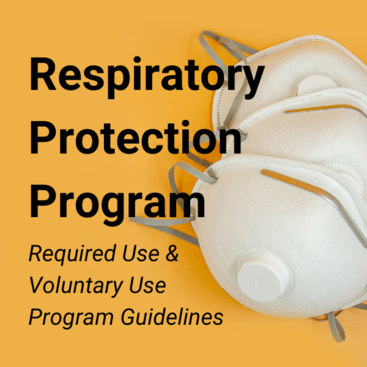Respiratory Protection
EH&S evaluates workplaces for possible airborne hazards and recommends ways to reduce these hazards when found. When appropriate, EH&S will fit campus workers with respirators and provide annual training on their proper use. EH&S evaluates a person's ability to safely wear a respirator prior to a respirator being issued in accordance with Cal/OSHA regulation 8 CCR 5144.
Voluntary Respirator Use is characterized by the employee requesting to use an N95 respirator when not required by the employer.
Mandatory Respirator Use is characterized by the employer requiring the employee to wear an N95 respirator when performing potentially hazardous activities.
Reference the table below to determine whether to submit a Voluntary Use or Mandatory Use respirator request.
For more information contact ehsih@ucr.edu.
Examples of Voluntary Respirator Usage
|
Examples of Mandatory Respirator Usage
|
Respiratory Protection Resources
-
COVID-19 Guidance for Respiratory Protection
COVID-19 Guidance
Healthcare
Staff specific guidance from the Centers for Disease Control (CDC)
- Recommended Guidance for Extended Use and Limited Reuse of N95 Filtering Facepiece Respirators in Healthcare Settings
- Healthcare Supply of Personal Protective Equipment
- Strategies for Optimizing the Supply of PPE
- Proper Donning and Doffing of PPE for COVID-19 Protection in Healthcare
- 3M COVID-19 Information Page
Staffand public guidance
- COVID-19 Campus News & Updates
- From the Center for Disease Control:
- How To Protect Yourself
- Schools, Workplaces & Community Locations
- 3M General Public Respiratory Protection COVID-19 FAQ
-
Resources & Forms
Campus resources
- Appendix D to 29 CFR 1910.134 (Non- Mandatory) and 8 CCR 5144 (Non- Mandatory)
- EH&S Respiratory Protection Voluntary Use Affidavit
- Filter and Cartridge Change Out Schedule
- Porta Count Respirator Fit Test SOP (Coming Soon)
- Procedures for Respirator Care and Maintenance
- Respiratory Protection Decision Logic Sequence
- Respiratory Protection Request Link (Respiratory Hazard Evaluation)
- Respiratory Protection – Online Training Link
- “Simply Book” Fit-Test Appointment System Link
External references
-
Wildfire Smoke
Smoke from wildfires in Southern California may contribute to poor air quality in the Riverside area during the fire season. Be prepared!
Smoke can irritate the eyes and airways, causing coughing, a scratchy throat, and irritated eyes and sinuses. Substances released from fires far away, while very unlikely to cause any significant health hazards, can contribute to headaches, nausea, and dizziness. Elevated particulate matter in the air can trigger shortness of breath and/or wheezing in those who suffer from asthma, emphysema or COPD. For most people, the conditions in the Riverside area become unpleasant rather than dangerous. However, elderly persons, children, and individuals with respiratory illnesses are particularly susceptible to elevated air pollution levels and should take extra precautions to avoid exposure.
